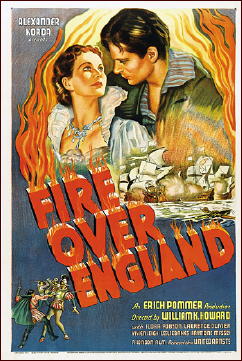July 2014
Monthly Archive
Wed 2 Jul 2014
FIRST YOU READ, THEN YOU WRITE
by Francis M. Nevins
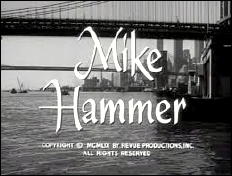
Anyone who’s read Mickey Spillane’s Mike Hammer novels — by which I mean the early ones, dating from 1947 to 1952, the ones in which Spillane overturned the whole Hammett-Chandler PI tradition by portraying Hammer as a sadistic psycho — has his own idea who should have played the character on screen.
There’s a consensus that the actors cast in the part were inadequate except perhaps for Ralph Meeker in director Robert Aldrich’s subversive version of KISS ME, DEADLY (1955), where Hammer is not the Cold War jihadi Spillane imagined but a cheap punk. It may not be coincidence that Meeker bore a certain physical resemblance to Spillane.
For my money the ideal screen Hammer would need to be a big bruiser, and of the actors from the period who are familiar to me the one I see as most like the character Spillane created was Lawrence Tierney (1919-2002). I challenge anyone to watch Tierney in that fine film noir BORN TO KILL (1947) and tell me he isn’t Hammer to the life. And judging from what I read on the Web, he was also a raging bull in the real world, serving several jail terms for beating people up in bars.
The years of the early Spillane novels coincided with the dawn years of television, but the medium’s antipathy to sex and strong violence seemed to rule out Hammer as a star of the small screen. Then in the late 1950s the character invaded America’s living rooms in the person of Darren McGavin (1922-2006), who went on to star in several other series including RIVERBOAT, THE OUTSIDER and KOLCHAK, THE NIGHT STALKER.
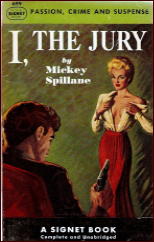
According to an interview McGavin gave decades later (Scarlet Street, Fall 1994), “Universal had made a contract with Spillane, and they made three pilots, one with Brian Keith. They couldn’t show them because they were all too violent.â€
The Keith pilot was written and directed by soon-to-be-superstar Blake Edwards (1922-2010). I’m told on the Web that it’s out there, and someday I’d love to see it. Keith as he looked in the Fifties strikes me as an excellent choice for the part, certainly more so than McGavin, who like Ralph Meeker resembled Spillane more than the Mick’s most famous character.
“I was doing a play in New York,†McGavin recalled, “and they called me to come out and do this series. I read the script…[and] said, ‘This is ridiculous! I mean, you can’t take this shit seriously….[T]his is satire. It’s gotta be satirical.’ [The producers] said, ‘No, no, no—this is really very deadly, straight-on, dead-on serious.’â€
McGavin insisted on playing the part his way, and Universal bigwig Lou Wasserman came down to the set and told him, “You can’t make fun of this material.†McGavin said, “I’m not making fun of it, I’m just treating it in a lighter manner…. We have a contract for me to say the words that are put on the paper. I don’t want anybody telling me how to do it.†What the hell did he think a director was for? Amazingly, McGavin wasn’t fired, and according to him, the episodes “were instantly successful. People thought they were funny.â€
Spillane couldn’t have cared less how the character was portrayed, telling TV Guide “I just took the money and went home.†That magazine’s reviewer declared that HAMMER “could easily be the worst show on TV.†I have yet to find anyone who considered the program a laugh riot but it certainly was successful, running for two seasons of 39 episodes each. All 78 can be accessed on YouTube and are also available on a DVD set.
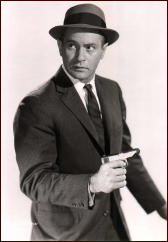
If the series wasn’t like the Hammer novels and wasn’t a comic parody of Spillane either, how can we describe it? I suggest we think of it as a sort of visual counterpart of Manhunt, the digest-sized crime magazine that debuted in 1953, at the height of Spillane’s popularity, and printed tons of tales by those hardboiled writers who were clients of the Scott Meredith literary agency. I don’t think it was by chance that later in the decade several of those writers got to crank out Hammer scripts, or have their Manhunt stories adapted for the Hammer series, or both.
To take the latter situation first, let’s look at Evan Hunter (1926-2005). By the time Hammer made it to the small screen, Hunter was writing mainstream bestsellers under his official name and the 87th Precinct police procedurals as Ed McBain. Earlier in his career he’d been writing tons of short stories for the hardboiled mags.
It was in Manhunt that readers of the Red Menace era first encountered an edgy alcoholic PI named Matt Cordell. Although originally published as by Evan Hunter, the byline and the protagonist magically changed their names to Curt Cannon when the stories were collected as the paperback original I LIKE ‘EM TOUGH (Gold Medal pb #743, 1958), soon to be accompanied by the novel I’M CANNON—FOR HIRE (Gold Medal pb #814, 1958).
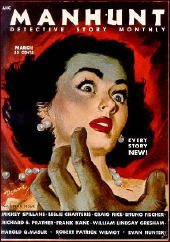
Hunter’s career had skyrocketed so far into the stratosphere that he wasn’t interested in writing for the Hammer TV series, but three of his six Cordell stories from Manhunt were adapted by others into Hammer scripts. Hunter, needless to add, was a Scott Meredith client. So was Henry Kane (1908-1988), who found one of his Manhunt tales about PI Peter Chambers reconfigured as a Hammer exploit.
So was Robert Turner (1915-1980), who devoted a chapter of his memoir SOME OF MY BEST FRIENDS ARE WRITERS BUT I WOULDN’T WANT MY DAUGHTER TO MARRY ONE! (Sherbourne Press, 1970) to his experiences working on the Hammer series. As Turner tells it, a whole pile of Scott Meredith clients got flown out to La-La Land and tried their hands at writing for the program but only a few succeeded.
First and by far the most successful was Frank Kane (1912-1968), who was credited with 14 original scripts, 5 more written with a co-author, and 6 Manhunt tales (three of them about his own PI Johnny Liddell) Hammerized either by himself or somebody else. Kane had a habit of using gallows-humor titles for his novels and stories, and both he himself and others tended to use the same type of title for their HAMMER episodes.
Witness the following lists:
KANE NOVEL OR STORY
Bare Trap
Gory Hallelujah!
Lead Ache
Morgue-Star Final
Poisons Unknown
Slay Ride
Slay Upon Delivery
Trigger Mortis
HAMMER SCRIPT BY KANE
Crepe for Suzette
A Detective Tail
A Grave Undertaking
Lead Ache (based on Kane’s short story)
Skinned Deep
Slay Upon Delivery (not based on Kane’s short story)
HAMMER SCRIPT BY SOMEBODY ELSE
Bride and Doom
The High Cost of Dying
Just Around the Coroner
Merchant of Menace
My Fair Deadly
Stocks and Blondes
Swing Low, Sweet Harriet
Robert Turner described Kane as “a big, bluff, hearty guy with a sometimes bawdy but always lively sense of humor… He drove [the producers] crazy, because he steadfastly refused to make carbon copies of his scripts.†He “could turn out a first draft in one or two days. He never gave it to [the producers] right away, though. Not after the first time, when they told him it couldn’t possibly be any good if he’d written it that fast. From then on he just threw the thing in a drawer for two or three days and visited around the lot.â€
He “would come to Hollywood for a month, write four or five scripts, and as soon as the last one was finished and okayed wouldn’t even wait for his check, but would head back to his family in New York….He always took the train….â€
Another well-known crime novelist turning out Hammer exploits was Bill S. Ballinger (1912-1980), who under his B. X. Sanborn byline wrote about a dozen scripts for the series. Most of what didn’t come from East Coast hardboilers was the work of four men who over the years turned out a small army of scripts for Revue Productions’ syndicated TV programs: Fenton Earnshaw, Lawrence Kimble, Barry Shipman and, most prolific of all, Steven Thornley (reportedly a byline of prime-time teleplaywright Ken Pettus).
How about the guys who called the shots? The busiest of the Revue contract directors who worked on HAMMER was Ukraine-born Boris Sagal (1923-1981), who signed 20 of the initial 39 episodes plus 5 from the second season. Sagal soon became one of the top TV directors but his career came to a messy end: while filming the mini-series WORLD WAR III, he walked into the tail rotor blades of a helicopter and was partially decapitated.
Also noteworthy among the first season’s directors was John English (1903-1969), one of the great action specialists who spent much of his creative life helming B Westerns and cliffhanger serials at the legendary Republic Pictures. English moved into television when the new medium displaced theatrical B features and spent several years at Revue.
He directed only five segments of HAMMER but “Peace Bond†boasts perhaps the most exciting climax of any of the 78 episodes. McGavin’s mano a mano with an evil lawyer (Edmon Ryan) represents Republic-style action at its no-prop-left-unsmashed finest, every moment perfectly choreographed and complemented by the background music of Republic veteran Raoul Kraushaar.
English’s best bud at Republic was my own best friend in Hollywood, William Witney (1915-2002), the Spielberg of his generation, a wunderkind who at the start of his career was the youngest director in the business. Between 1937 and 1941 the two co-directed 17 consecutive Republic serials, their visual styles so much alike that they often got into arguments about who had shot what.
In the late Fifties, after Republic folded, Witney wound up at Revue, directing episodes of many of the same series English was working on, including MIKE HAMMER. During its second season Bill helmed 13 segments, far more than anyone else except Boris Sagal.
His HAMMER work benefits from innovations like devising L-shaped sets, with the camera positioned at the right angle of the L so he could have it point east and shoot one scene while the technicians were preparing the north arm of the L for the next sequence, then have it swing around, point north and shoot that scene while the crewmen were tearing down the furnishings from Bill’s first shot and setting up what was needed for his third.
If you watch only one of his 13 HAMMER segments, make it “Wedding Mourning†— the last episode filmed, he told me — in which Hammer for once is portrayed as something very close to the brutal psycho Spillane all unwittingly had created. Mike falls for a woman and is about to get married and change his life when his love is murdered and he runs amok, shooting and beating a swath through New York’s lowlifes. If any of the 78 HAMMER episodes qualifies as telefilm noir, this is it.
In the cast lists of any Fifties series you’re likely to find a number of men and women who were prominent in movies from earlier decades and others who were to become famous on TV in the Sixties or later. Among those once better known who appeared in HAMMER episodes were Neil Hamilton, Allan “Rocky†Lane, Keye Luke, Alan Mowbray, Tom Neal and Anna May Wong. The first three also enjoyed later TV fame, respectively as BATMAN’s Commissioner Gordon, the voice of the titular horse on MR. ED, and KUNG FU’S Master Po.
The actors who weren’t all that well known at the time of their HAMMER roles but made their marks later include Herschel Bernardi, Barrie Chase, Michael Connors, Angie Dickinson, Robert Fuller, Lorne Greene, DeForest Kelley, Dorothy Provine and Robert Vaughn. Anyone who can identify all these folks’ claims to fame either is a telefreak of the first water or has the DVD set.
While cobbling this column together I was presented with a copy of the set and have begun watching the episodes. Some of them I haven’t seen in many years, others — mainly those directed by Bill Witney or Jack English — I taped when the series was broadcast on the Encore Mystery Channel.
Will I make it through all 78? Dunno. Will I find anything interesting enough for another column? No idea. But if McGavin’s later PI series THE OUTSIDER ever comes out on DVD it might be worth exploring.
Tue 1 Jul 2014
Reviewed by JONATHAN LEWIS:
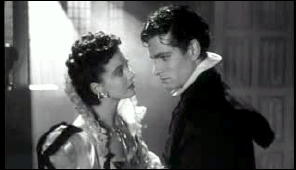
FIRE OVER ENGLAND. United Artists, UK/US, 1937. Flora Robson, Raymond Massey, Leslie Banks, Laurence Olivier, Vivien Leigh, Lyn Harding, Robert Newton. Based on a novel by A. E. W. Mason. Director: William K. Howard.
Fire Over England is an historical drama set in the late 1580s. Based on a novel of the same name by A. E. W. Mason, the movie takes place during the reign of Queen Elizabeth as the Anglo-Spanish War (1585-1604) rages on.
The film has a captivating plot, very good cinematography by James Wong Howe that makes excellent use of shadow and lighting, and a memorable soundtrack. It manages to pack quite a bit of action in 92 minutes. While there aren’t any truly outstanding moments in the film, it’s overall a well-executed project. The maritime fight scenes, in particular, are extremely watchable.
We begin in the Court of Queen Elizabeth (Flora Robson). A frantic Cynthia, portrayed by Vivien Leigh in what was to be her first on screen performance with future husband Olivier, is fluttering about. Then we hear the film’s first voice. It’s that of James Mason, in an uncredited role as Hillary Vane, a distinctively bearded Englishman who we soon learn is traitor and an agent for King Philip II of Spain.
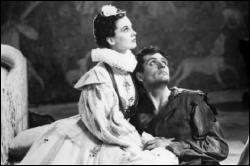
Soon after, we encounter Michael Ingolby (Olivier), a patriotic, if somewhat youthful Englishman. He and his father, Sir Richard Ingolby (Lyn Harding), are traveling on an English vessel that is captured by the Spanish. Michael escapes and swims ashore. His father isn’t so lucky. Sir Richard Ingolby is captured and burned to death at the Inquisition in Lisbon. The younger Ingolby witnesses the smoke over Lisbon, learns that his father died there, and develops a hatred of Spain.
But then it gets complicated, for he has developed feelings for Elena (Tamara Desni), a Spanish girl who saved him following his escape. Even so, Ingolby returns to England. There, he woos his beautiful fiancée, Cynthia (Leigh), and metaphorically butts heads with the Queen. His wit and daring impresses the publicly fierce, but privately fragile, monarch as to his true abilities and his loyalty. Soon, Ingolby assumes the now dead traitor Vane’s identity and returns to Spain to act as a spy in the palace of King Philip II (Raymond Massey, below and to the right).
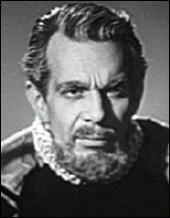
After a series of twists and turns and an coincidental but inevitable encounter with Elena and her now husband Don Pedro (Robert Newton), Ingolby makes his way back once again to his island homeland. Once there, he leads men in battle against the encroaching Spanish Armada. When it’s all over, it’s the burning of the Armada that in the end creates flames all over England. (In an earlier entreaty to the Queen, an impassioned Ingolby had warned of the Spanish menace and how, if the English did not act soon, the Spaniards would rain fire down on England.)
With a cast such as this, it’s no surprise that the film benefits from its above average to superb acting, much of it quite theatrical. Olivier was around thirty years old when Fire Over England was made and his talent is on display throughout the film. Leigh’s work in the film led directly to her being cast as Scarlett O’Hara in Gone With The Wind.
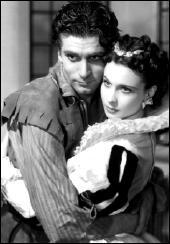
Although their onscreen pairing would culminate in real life marriage, the chemistry between Olivier and Leigh, while definitely palpable, just doesn’t come across as strong as that between Olivier and Desni. Perhaps that is the case because there was far more tension between Olivier and Desni’s characters than between Olivier and Leigh’s.
For his part, Raymond Massey is perfectly fine in his portrayal of the rather taciturn Philip II. His is just not a particularly memorable performance. Flora Robson’s portrayal as Queen Elizabeth, however, really is quite remarkable. One just imagines that Queen Elizabeth would have come across quite similar to how Robson portrays her in this film.
Released in 1937, Fire Over England does seem to make implicit allusions to England’s contemporaneous concerns over the rise of Nazi Germany. Spain is presented not just as a great power rival, but as a totalitarian force that threatens English liberty. It’s somewhat ironic then, that in film with such strong pro-English sentiment, that the characters with the most depth to them are the Spaniards, Elena and Don Pedro, both of whom are faced with far more difficult moral choices than any other characters in the film.
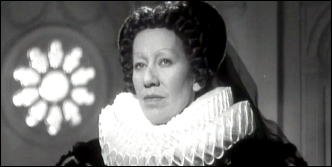
In conclusion, Fire Over England is a well above average movie and one that anyone with an interest in early British cinema, in particular, should seek out. (The film is in the public domain, so there are likely copies of varying quality available.)
While it may not be among the best historical epics ever produced, it’s still a very good film, one that showcases the talents of two actors who would go on to even bigger and better projects, both in the movies and in their personal lives.
Tue 1 Jul 2014
COLLECTING PULPS: A MEMOIR, PART ELEVEN —
Frank Robinson, 1926-2014
by Walker Martin
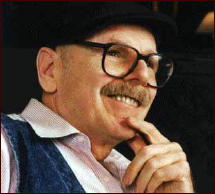
I’ve just learned that Frank Robinson died on June 30, 2014. Another of my old pulp friends that I will miss and one less of the collectors who used to actually buy the pulps off the newsstands in the thirties and forties. Frank was born in 1926 and was 87 years old at the time of his death.
Frank wore many hats, and I’m not talking about the hat that he always wore. He was an SF author, a writer of mainstream action fiction, an editor for the men’s magazines such as ROGUE, CAVALIER, PLAYBOY, a speechwriter for Harvey Milk, who was shot and killed in the 1980’s, a member of the San Francisco gay community, and finally at the end of his life, a movie actor. (He had a bit part playing himself in the movie, MILK.)
However, though I was aware of all the above, I knew him only as one of the most intense and fanatical pulp magazine collectors that I have ever known. He was a “condition collector” and probably the top such collector among pulp collectors. Frank just didn’t collect nice condition pulps; he collected magazines that were often in perfect condition with white pages and glossy, new looking covers and spines. This is getting harder and harder to do because the pulp era is now many decades in the past, the last ones dying in 1955. (There are a couple of exceptions such as RANCH ROMANCES.) Some of the beautiful magazines that Frank collected are now close to a hundred years old.
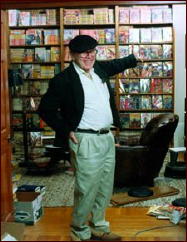
I first came into contact with Frank in the early 1980’s when he wrote me about some of his wants. We corresponded for many years and traded pulps back and forth. Not an easy thing to do because Frank only wanted perfection. He had what other collectors called “the wall of pulps” and they were all in fine or mint condition. His SF magazines were probably the best condition set in existence and his WEIRD TALES were a thing of beauty.
During our correspondence, it was only natural that the subject of Pulpcon would arise. I urged him to attend the annual convention which was usually held in the Dayton, Ohio area. He eventually went to many of the conventions in the 1980’s and 1990’s and was finally awarded Pulpcon’s highest honor, the Lamont Award, at Pulpcon 29 in 2000.
When I think back on our many conversations at Pulpcon, I cannot recall a single non-pulp related discussion. All we ever talked about were book and pulp matters. Wait — I do remember once showing him an original pen and ink illustration from a SF magazine that was used on one of his stories, but that was just about as far afield as we ever strayed.
And that was how I liked it. Pulpcon was like a big book and pulp party, as if you had died and had gone to heaven. No families, no problems, forget your worries and just dive right into a gigantic room full of old magazines and books. I once had a friend who carried on an affair with a motel maid during the convention. When he told me about it, I was puzzled. Why, was my response. Sex could be pursued the other 51 weeks of the year. Why bother during Pulpcon?
Frank felt the same way. Usually he could be found sitting behind a table comparing pulps and upgrading his magazine collection. You couldn’t miss him with his trademark golf cap and sonorous, deep voice. Pulpcon once had a guest that had worked at Ziff Davis as Frank had back in the forties and when he heard The Voice, he immediately knew who it was and yelled, “Why it’s that kid from the mailroom!”. He didn’t recognize the face but you could never forget Frank’s voice.
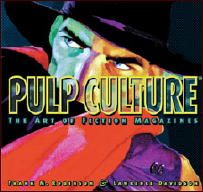
Great collectors compile great collections not just by buying them but also by helping other collectors. I’ve run into this a hundred times with old-time collectors over the years. Here are some examples where Frank attempted to help me with my collection:
1. During our correspondence, Frank asked me for my want list. At the time I was collecting just about every major pulp title except for the love, sport, and aviation/war magazines. Therefore it was several pages long and handwritten. He found several of my wants and we traded back and forth. A couple months later, I received in the mail a neatly typed manuscript. It was my handwritten want list that Frank had typed and without errors. It must have taken him hours to do it.
2. Upon hearing that I had 112 SEA STORIES and only needed 6 issues for a complete set, he said he was willing to let me have his issues if he had the ones I needed.
3. I was once talking about how I had various parts of the famous October 1912 Tarzan issue of ALL STORY but I was missing some pages. He offered to try and put together a complete issue if he could manage it.
4. Since that didn’t work out, once Frank was at an auction on the east coast, and called me at work. He wanted to know how high I was willing to bid on the Tarzan issue and he would bid and get it for me. Unfortunately I was only prepared to go as high as $5,000 and someone else got it. But this is another beyond the call of duty or friendship action.
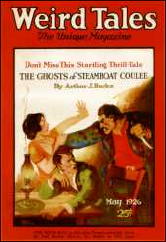
As Frank got older, I guess he finally reached the point that we all eventually get to. He decided to find another home for his great collection. One of the great magazine auctions of several decades was held by Adventure House a couple years ago. It was simply called The Frank Robinson Collection auction and of course all serious collectors started to squirrel away money, borrow and rob the family bank accounts, lie to their non-collecting spouses, and otherwise act in ways that would be frowned on in polite society.
I knew that most of the Robinson collection would be beyond my means because of the premium that we put on nice condition pulps. Fortunately I had most of the magazines already in lesser shape. But I did want something from the Frank Robinson Collection for my own collection and in memory of our friendship. I was fortunate to get several WESTERN STORY MAGAZINE issues from the early twenties in beautiful condition. But even these white paper artifacts cost me a lot more that I had thought they would. Each issue cost me over $100. A friend of mine got caught up in a bidding war and paid over $900 for a magazine that was worth less than a hundred.
So I knew I was in dangerous territory. For instance the WEIRD TALES set went for over a quarter of a million dollars. But as all collectors know, you can always get more money, but rare books and pulps are not so easy to find. All collectors make mistakes. One of mine was selling my set of the 71 issues of PLANET STORIES for a thousand dollars several years ago. True, my set was not that great condition but I missed the garish, good girl art covers and the space opera. The letter columns were of great interest and fun to read.
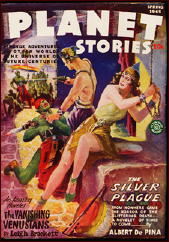
I decided to get the PLANET STORIES set at the Robinson auction. I knew they would go high, maybe cost more money than I would want to spend. I had sold my beat-up set for peanuts, which came to $15 each. What would the best condition set in the world go for? I knew the copies were perfect, white pages, bright, newsstand fresh covers and spines and that new pulp smell. They were new, 60 to 70 years after being printed!
Even at $100 each the set would cost $7100 and I knew such condition would force the bidders to go higher that $100 each. It sure did but after the dust settled, I was the proud owner of the greatest set of PLANET STORIES in existence. Not just in the world but in existence! If you are a serious book or magazine collector, then you know this feeling. At first I figured I paid too much, but maybe not because I soon was offered my money back plus a set of PLANET STORIES in nice shape if I would sell the Robinson copies. I refused of course.
Shortly after the above events, I went to the Windy City pulp show in Chicago. Doug Ellis had invited a few art and pulp collectors out to his house for lunch before the start of the convention. I was wandering through looking at the pulp art when I heard the sound of snoring on a couch in the basement. I went over and there was Frank Robinson laying flat on his back, sleeping. With his hat on! I stress the hat because Frank always had the golf hat on and even swam with it on according to reports. Well, now I knew that he even slept with the hat on.

I didn’t say anything, but in a daze I went upstairs and said to Deb and Doug, “What’s cooler that having pulps from the Frank Robinson Auction?” “Having Frank himself as part of your collection!” Well of course he was just visiting, and I went back downstairs and looked at him again. This time he woke and without a second’s hesitation, said “Hi Walker” and proceeded to talk about pulps. I told him I had a special stamp and ink pad made and I was going to stamp each issue of PLANET STORIES on the cover and contents page the following statement: FROM THE FRANK ROBINSON COLLECTION.
Of course I would be crazy to do that but I have been called crazy before. The magazines are so perfect that I’m afraid to handle them and I certainly can’t read them without degrading the condition. However, I solved my problem by buying back my beat up set that I had sold for $1,000 a dozen years ago. This time it cost me $1,700 to get them back. Now I have two sets of PLANET, one to read and one as a shrine to the memory of Frank.
My last conversation with Frank was a couple years ago. I was looking at some WEIRD TALES that looked perfect and were up for auction. I heard that distinctive voice say, “Hey Walker, look at the paper inside.” I did and it was browned and brittle. We grinned at each other.
RIP Frank.
« Previous Page









